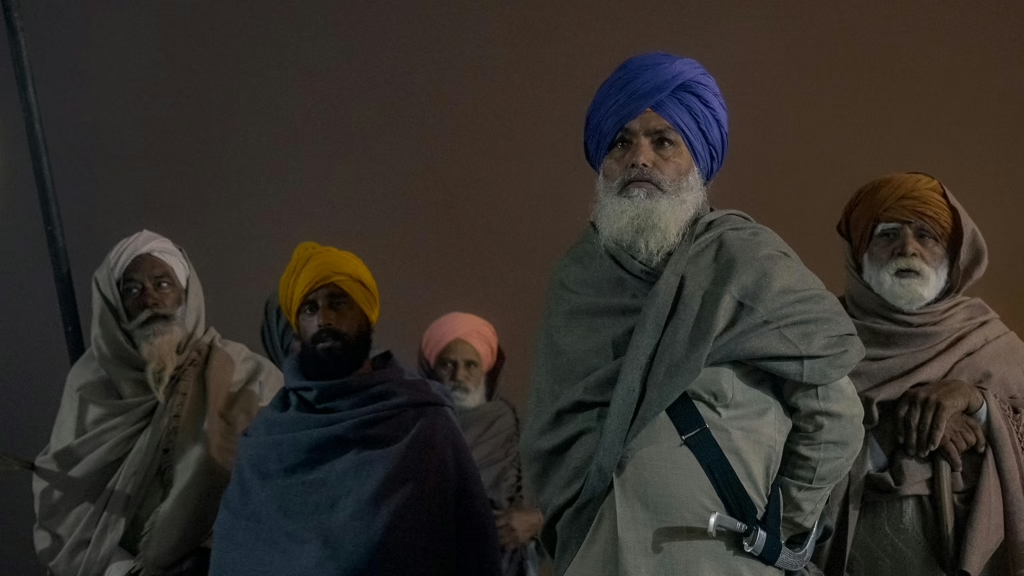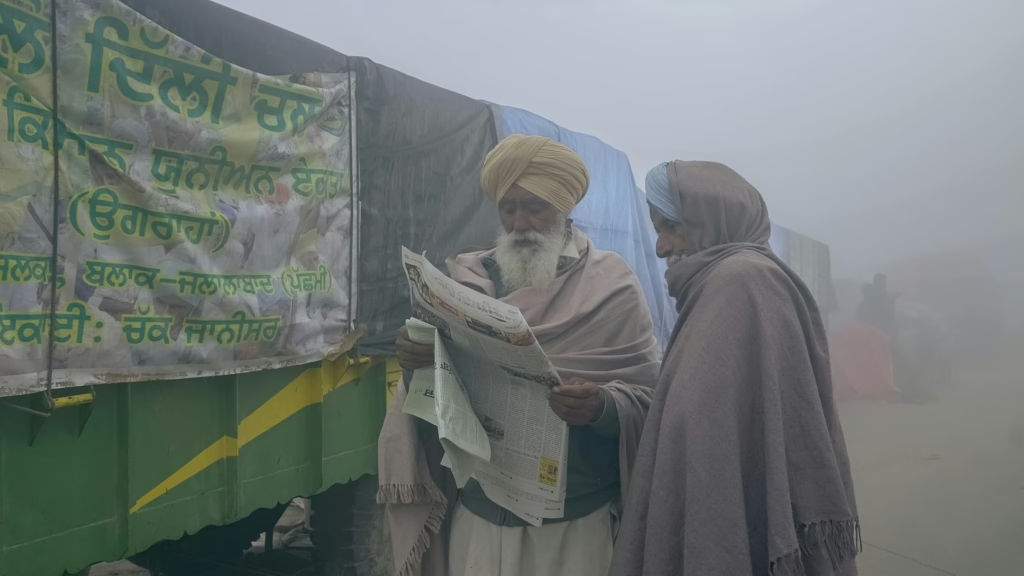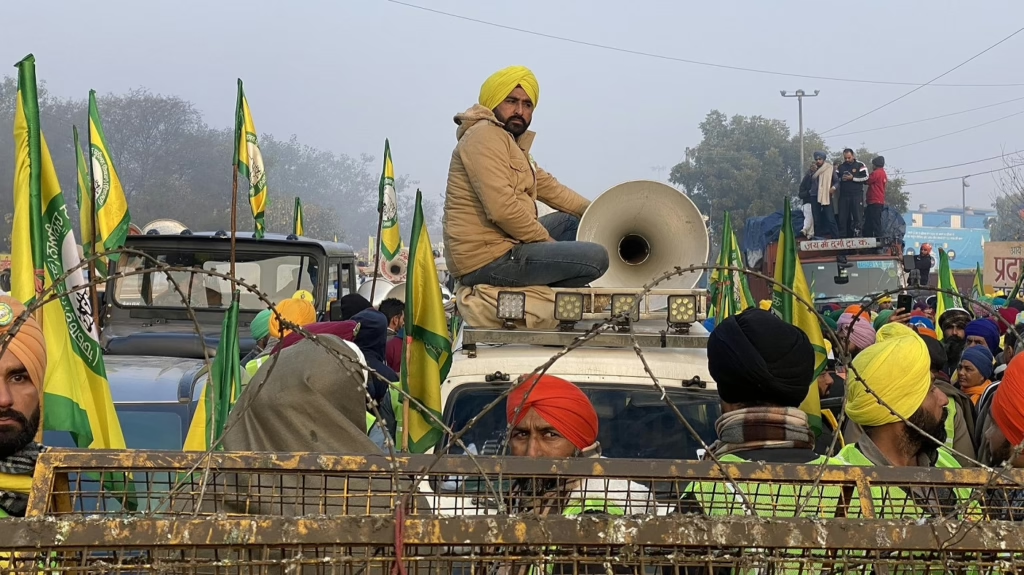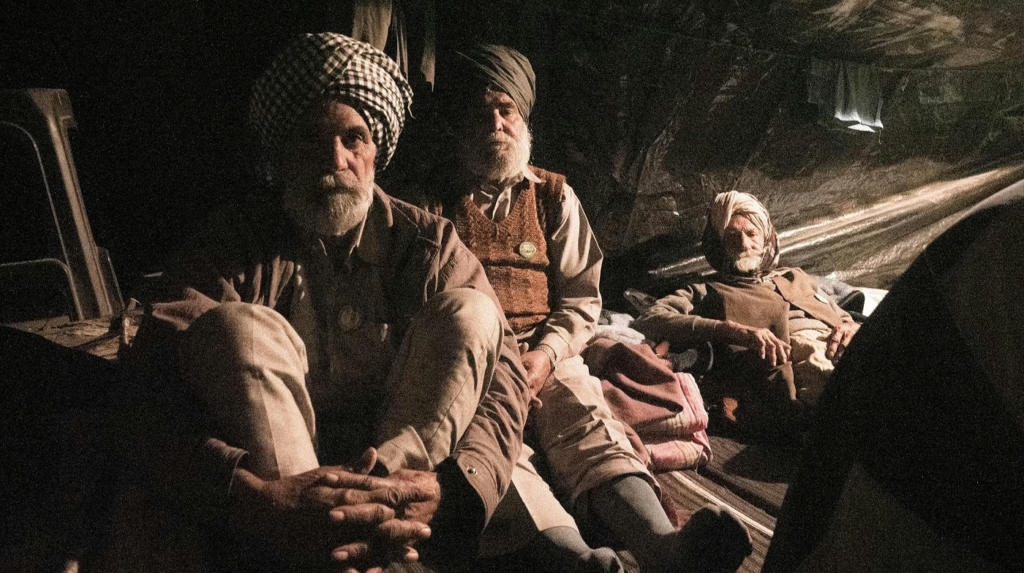In fall 2020, thousands of Indian farmers began protesting new agricultural laws introduced by Prime Minister Narendra Modi’s government. Frustrated by legislation they felt threatened their livelihoods, farmers from Punjab and Haryana states staged massive demonstrations along the borders of New Delhi. Documentary filmmaker Nishtha Jain knew this uprising had a powerful story to tell. Over the next year, she and co-director Akash Basumatari immersed themselves in the protests, witnessing both the determination and hardship of those fighting for change.
The controversial farm laws opened India’s agricultural sector to private investors, allowing large corporations to negotiate directly with growers and store crops privately. Farmers believed this could drive down prices and displace them from their land. When attempts to reform the legislation stalled in Parliament, organizers called farmers across northern India to the nation’s capital in an act of non-violent civil disobedience. What started as highway blockades swelled into encampments of hundreds of thousands, shaking the government.
Jain set out to chronicle how the movement evolved through ordinary voices and everyday acts of solidarity. In her film Farming the Revolution, intimate vérité footage brings us into the protest camps. We meet farmers, workers, and activists sustaining relentless demonstrations with improvised shelters, shared meals, and performances of cultural heritage. Intermittent news clips contrast their reality with misleading coverage, smearing protesters. Over changing seasons, the documentary captures both political milestones and personal sacrifices, sustaining hope against formidable odds.
Jain’s acclaimed documentary gives an insightful, moving perspective on grassroots democracy in action. Her restrained yet empathetic storytelling honors those defending an agricultural way of life with quiet resolve. Let’s explore how Farming the Revolution introduces us to this decades-long struggle.
Speaking Voices: The Story of a Movement
“Farming the Revolution” tells the story of the farmers’ protests in India through a three-act narrative that immerses viewers in the evolving protest. Director Nishtha Jain artfully balances broad scenes showcasing the movement’s massive scale with intimate portraits of individuals. This approach ensures we understand both the collective spirit driving the protests and the personal motivations sustaining individual commitment over 13 long months.
The film opens by introducing the issues fueling farmers’ anger and their initial demonstrations. We see countless tractors and trucks flooding highways towards New Delhi as a united front forms to demand new agricultural laws be repealed. While police barriers attempt to block their path, protesters’ determination can’t be denied. Camps spread along the borders, swelling in size daily with new arrivals. Poetry and songs fuel the spirit of past resistance movements, reminding us all that change requires perseverance.
Among the crowds, some stand out, like Veerpal Kaur, a farmer and activist who leaves her job to fully commit to the cause alongside her sister. Their family’s leftist values strengthen their support for the farmers’ unions. Meanwhile, young farmer Gurbaz Sangha finds himself taking on new roles, learning how movements evolve. Through such figures, we experience the protests intimately yet also grasp their broader reach.
As weeks stretch into months with no response from the government, challenges like harsh weather and a lack of progress take their toll. But the protesters’ quiet resilience is most powerful during these low points. Ultimately, their unity and refusal to back down achieve success, though further demands remain. The characters’ journeys conclude, each now more empowered to advance the social change the movement represents. By portraying the whole revolution in this three-dimensional way, “Farming the Revolution” pays worthy tribute to the farmers’ inspiring story.
Visual Poetry of a Movement
Nishtha Jain’s cinematography tells the story as much as her narrative. Sweeping drone shots bring the sheer scale of the protests into crisp focus, with small rivers of people flowing into vast seas. Yet her camera also zooms in, sharing intimate moments within the camps that showcase humanity—men preparing food for others, women finding community.
Seasons become another character, the natural world reflecting the emotional arc. Winter fogs envelop protesters bundled against the cold, but their determined faces remain resolved. Hot summer dust swirls as crowds gather each morning with the same resolve. Through these scenes, we feel both the hardship and resilience of persisting when others might falter.
Faces alone carry the story at times. A young farmer steadies his gaze directly into the lens, his conviction and youthful strength mingling. An elder’s eyes hold wisdom earned through years of struggle and hope for more just futures. Their surroundings may change with the turning of the of the world outside the camps, but from face to face, the message remains constant: this movement seeks fairness for all.
With poetic visuals enhancing profound themes, Jain crafts not simply a documentary but a piece of visual art. Her camera acts with intention and care, inviting audiences to feel this moment in history through senses as much as facts. The results linger long after the final frames, an enduring testament to both artistry and the human spirit.
Farmers United: The Power of Community in Protest
At its heart, Farming the Revolution celebrates the strength of unity. Through intimate glimpses of life in the protest camps, we see communities formed in the direst of circumstances. Men cook together and share meals, finding solidarity in shared purpose. Women stand as equals, and recognizing their vital contributions strengthens the whole.
Despite months of hardship, songs and laughter ring out. Makeshift medical tents aid all in need. Libraries and lectures share ideas supporting their cause. Between seasoned activists and young volunteers just finding their voice, an atmosphere of learning emerges. Their cooperation reminds us that together, ordinary people achieve extraordinary things.
This spirit particularly shines through the film’s women. Sisters Veerpal and Beant dedicate themselves fully, rallying others with their conviction. Figures like Harbinder exemplify grassroots female leadership. Scenes of women preparing food or raising children beside the protests drive home their equal stake in the movement’s success.
Meanwhile, shots of vast crowds emphasize people’s collective power. United, half a million voices prove louder than any smear campaign. Months of nonviolent noncompliance ultimately forced even an obstinate government to heed the public will. Their hard-won victory shows that when the marginalized unite, real change can happen.
Yet Farming the Revolution presents the protest’s toll as well. Glimpses of exhausted faces underscore the exhausting longevity of their struggle. All suffered difficult conditions, some giving their lives. The film honors each sacrifice through intimate humanization of their plight. In sharing protestors’ quiet resilience, it passes their baton of hope and solidarity to a new generation.
Sound of Resistance
Farming the Revolution immerses viewers in the sounds of protest through the artful use of diegetic and non-diegetic elements. Director Nishtha Jain deftly interweaves audio of passionate speeches and folk songs with news clips that demonize the movement. But she skillfully lets the protestors’ voices speak for themselves, resisting the urge to cut away to external commentary. This preserves the vérité style and keeps us grounded in the lived experience.
Sound designer Niraj Gera plays a key role, transporting us into the bustling protest camps. Beyond capturing the vibrant energy of crowds, he catches intimate moments that deepen our connection to individuals. Subtle ambient noise also reminds us that life goes on within these mobilized communities.
Gera’s work is complemented by Florencia Di Concilio’s compelling score. Her musical motifs rise and fall with the tides of resistance, enhancing emotional impact. Uplifting themes accompany scenes of solidarity and celebration, while somber tones match periods of despondency. Like the film itself, her score acknowledges both hope and hardship as inherent to the struggle.
Together, Gera, Di Concilio, and Jain craft an immersive soundscape that brings movement to our ears. They allow protestors’ stirring performances, from folk songs to fiery speeches, to become part of the narrative fabric. In doing so, Farming the Revolution conveys the audible spirit driving real change from below. Its balanced sound design keeps viewers fully engaged in the sounds of resistance.
Farming the Revolution Sows Seeds of Change
Nishtha Jain’s Farming the Revolution has been showered with praise since premiering at major film festivals. Most notably, it won Best International Feature Documentary at Canada’s prestigious Hot Docs festival in 2024—no small feat in a field of impactful films.
The documentary immerses viewers in the year-long protests by hundreds of thousands of Indian farmers against new laws threatening their livelihoods. Through intimate portraits and sweeping shots that convey the protests’ massive scale, Jain brings us into the encampments and struggles of ordinary people uniting in solidarity. She captures their unwavering spirit amid relentless challenges with sensitivity and nuance.
Farming the Revolution has resonated strongly with audiences, especially those drawn in by its festival acclaim. The film provides an accessible window into issues that deeply affect many lives but receive scant attention elsewhere. By focusing on individual stories within a historic movement, Jain effectively spreads awareness of challenges like the plight of farmers and grassroots responses to top-down power.
Her compelling documentation is sure to find more eager viewers as it reaches global streaming platforms. The timeliness and universal themes will continue to attract new eyes, who may learn from these protesters’ courage and lessons about collective action. Festival buzz also suggests the film remains in consideration for cinema’s highest honors.
Ultimately, Farming the Revolution has shed a necessary light on the struggles impacting so many. By redirecting attention to those stories frequently obscured, Jain cultivates understanding and expresses solidarity with challenges facing communities worldwide. She inspires by showing that persistence and unity can overcome even the most entrenched obstacles. Through her sensitive filmmaking, Jain sows seeds of change that may take root and bear fruit for years to come.
Farming the Revolution’s Enduring Message
While portraying over a year of determined protest, Farming the Revolution reveals truths that continue to inspire. At its heart lies defiance in the face of injustice and the power we possess when standing together for what is right.
The farmers refused to back down, enduring punishing heat and cold, rain, and hail. They withstood the slow grind of negotiations, yielding little and suffering losses along the way. Yet their conviction only grew as more people joined their call. In the bustling protest encampments, people from all walks of life sustained each other through shared commitment.
Though this movement faced immense challenges, it succeeded by never losing sight of its goal—defending livelihoods and shaping the future. Leaders spoke passionately but knew real strength came from unity. Even as some lost hope, most regained it, seeing their cause bring out solidarity from unexpected places. Their quiet persistence could not be ignored, forcing those in power to listen at last.
While the story contains sadness, it leaves us with optimism. For when compassion drives us to lift each other up and compassion inspires taking a stand together, there may be difficult nights, but dawn always comes. Their triumph reminds us that change begins with communities acting as one. If we support each other like the farmers did along those highways, with courage and cooperation, we can overcome the toughest of times and build the just world we all wish to see. Some plant seeds in struggle that will nourish those yet to come.
The Review
Farming The Revolution
Summing it all up, Farming the Revolution offers a profound and poignant look at one of the largest grassroots movements India has seen. Through intimate yet wide-reaching portraits, it powerfully captures both the grand scale of the farmers' protest and the personal sacrifices of those sustaining it. While depicting challenges faced, the film leaves us inspired by human resilience and what we can achieve through solidarity and unified peaceful action against injustice.
PROS
- Powerful and moving portrayal of a massive people's movement
- Intimate glimpses into the personal stories and struggles of protesters
- Strong sense of spirit and community at protest encampments
- Evocative visual storytelling and scores that immerse the viewer
- Impressive scope and scale in capturing over a year of protests
- Inspiring message around collective action and peaceful resistance
CONS
- Some scenes feel overly long and could benefit from tighter editing
- Narrative focuses more on the collective than diving deeper into individuals
- Limited background is provided on farm issues and politics for some viewers






















































Discussion about this post